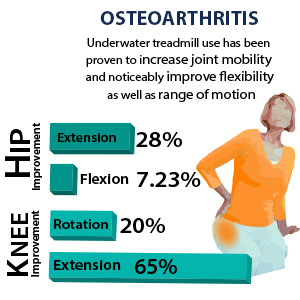How Aquatic Therapy Helps Osteoarthritis Patients
Millions of Americans groan as they roll out of bed in the morning, not due to a tyrannical boss or bad weather, but due to joint pain!
Osteoarthritis (OA) disrupts the lives of an estimated 27 million Americans. That’s just over 12% of our population, making OA a significant concern for physical and occupational therapists across the country. Below are a few common questions about osteoarthritis and why aquatic therapy, especially when implemented in a specialized therapy pool, can be very effective in mitigating OA’s effects.
What is Osteoarthritis?
Osteoarthritis, also called degenerative joint disease or degenerative arthritis, is the result of deteriorating cartilage due to use over time, causing pain in the hands, neck, lower back, knees or hips.
How Many People Suffer From Osteoarthritis?
Three million cases of OA are diagnosed each year, mostly among the middle-aged and older.
Is Osteoarthritis Curable?
OA is not curable. Medication, surgery, physical therapy and exercise are often used to reduce the effects.
Osteoarthritis Precipitators
Most of us will develop osteoarthritis, at least in our knees, by the time we are in our mid-80s. A few most common precipitators of OA in adults are:
- Age. As discussed, natural wear and tear on the body over time will decrease the existence of viable cartilage between joints.
- Weight. Joint pain is strongly associated with body weight. Studies show that being just 10 lbs overweight increases force on the knee by 30-60 lbs with each step. Approximately 67% of all men and women who are obese will develop OA during their lifetimes.
- Past injury. Post-traumatic arthritis is a common form of OA. We are three times as likely to have OA in a previously injured knee than an uninjured knee. Athletes and others demanding extended physical exertion typically face OA in their later years.
- Heredity. Some OA patients have an inherent defect in cartilage producing genes, causing an early breakdown of cartilage.
Why is Aquatic Therapy an Effective Treatment Tool For Osteoarthritis?
Physical and occupational therapists seek treatments for their patients to mitigate the disease’s painful symptoms. Aquatic therapy has been shown to be effective. Here’s why:
The buoyancy of water combined with the hydrostatic pressure produced during immersion make the aquatic environment uniquely beneficial in the management of patients with OA. Buoyancy allows for decreased joint stresses and weight-bearing through the lower extremities, which promotes a more pain-free way of exercising the necessary muscles. Hydrostatic pressure is the force of water on a submerged item due to gravity. During aquatic therapy, water pressure exerts against the body, acting as a full body compression, decreasing pain and edema.
Aquatic therapy has shown to be effective in reducing pain and stiffness and producing high rates of compliance. Also, studies show a patient preference for aquatic versus land exercises, with fewer adverse effects of exercise during aquatic programs. Aquatic therapy has been shown to improve strength and flexibility in individuals with OA. The decreased force on joints allows patients to successfully complete more aggressive weight-bearing exercises, decreasing the psychological impact of the condition.

How Does a Specialized Pool Help?
The properties of water and aquatic therapy can improve the lives of those suffering from OA. However, cool water temperature in most recreation or community pools may cause discomfort to OA patients. Also, the stride rates of pool “walkers” differ noticeably from their strides on land; pool walkers tend to “bob” and “toe walk.” This type of movement does not produce the correct posture, gait and range of motion that carries over to effective land-based ambulation.
The HydroWorx pool with underwater treadmill and resistance jets solves these issues, giving OA patients the most relief possible in an aquatic workout. The underwater treadmill allows patients a smooth, even gait, with heel-toe foot strikes, correctly simulating land-based biomechanics. The motion allows room for full hip rotation. A moveable floor gives physical therapists the ability to create the optimum water level for patients. Therapy pool temperatures are typically kept warmer which helps to loosen joints and improve range of motion. Resistance jets let patients test their balance prowess in a safe, secure environment. Hand rails support those unsure of their faculties and warm water massage hoses work to distribute built-up lactic acid and provide patients with a soothing end to a therapy session.
In a recent clinical study comparing an underwater treadmill exercise regimen to that of home exercise for pain relief and functional improvements in OA sufferers, researchers found the underwater treadmill users had better global improvement and higher patient satisfaction than those of the control group. Exercising in water using an underwater treadmill was found to be as effective as home exercise in relieving pain and improving function in obese people with mild to moderate knee osteoarthritis.
Osteoarthritis will continue to intensify its hold on our country as our nation’s median age continues to increase. Aquatic therapy with an underwater treadmill can offer relief to these patients from discomfort and allow them to strengthen muscle, build cardiovascular strength and improve balance, with reduced pain!


